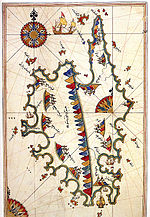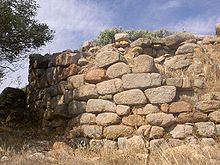Torrean civilization

The Torrean civilization was a
, during the second half of the second millennium BC.| History of Corsica |
|---|
 |
|
|
History


The characteristic buildings of this culture are the torri ("towers"), megalithic structures similar to the Sardinian nuraghes, from which the culture takes its name, and the castelli ("castles"), more complex buildings that include a wall, a tower and huts.
According to preliminary investigations conducted during the 1950s by the French scholar
Currently, the Torrean civilization is seen as an indigenous civilization, and the result of a local evolution started since the
However, some scholars think that Sherden may have migrated to Corsica from the west (
During the Iron Age, the towers and castles were still occupied,[7] but the relationships with Sardinia become less intense (the characteristic Nuragic bronze statuettes are absent in Corsica), while in the north there were increasing contacts with Tuscany and Liguria.[8]
The Torrean civilization disappeared in the middle of the
The Torrean people might be associated with the
Politics
The Torrean society was not organized into a complex political system with a strong central power; the villages of huts at the foot of the castles rather indicate that it was structured into small chiefdoms that dominated the valleys.[9]
Society

The representations in anthropomorphic statues reflect a
Religion
Torrean buildings with specifically religious functions are unknown, making it difficult to identify a possible priestly caste; religiosity was expressed, as in the past, in the maintenance of places like coffres (circular tombs with stone cists) and the dolmens.[3]
Economy
The economy was based mainly on agriculture and livestock, particularly of cattle, goats and pigs. In Bronze Age Corsica there was a notable expansion in metallurgy and trade with the East, as evidenced by the discovery at Borgo of a copper oxhide ingot and some cobalt beads, goods coming from Cyprus and the Aegean, respectively. However, there have been only sporadic discoveries of Mycenaean goods, which are quite common in Sardinia.
Gallery
-
Statue menhir from Palaggiu
-
Plans of torri and nuraghi
-
Alo-Bisucce
-
Statue menhir from Filitosa
-
Filitosa
See also
| Ancient history |
|---|
| Preceded by prehistory |
|
References
- ^ a b c d e Kewin Peche-Quilichini - Les monuments turriformes de l'âge du bronzeen Corse: tentative de caractérisation spatialeet chronologique sur fond d'historiographie
- ^ Jean Guilaine,Jean Zammit, The Origins of War: Violence in Prehistory p.16
- ^ a b c Kewin Peche- Quilichini - L'âge du bronze de la Corse
- ^ Kewin Peche-Quilichini, Révision desvaisselles chrono-culturelle de l'âge du Bronze de-Turrichju Filitosa (Sollacaro, Corse-du-Sud)
- ^ Paolo Melis: the relations between the northern Sardinia and Corsica in the ancient Bronze age.
- ^ Ugas 2005, p. 197.
- ^ Zucca 1996, p. 34.
- ^ Camps 1988, p. 256.
- ^ Costa 2004, p. 118.
Bibliography
- Camps, Gabriel (1988). Préhistoire d'une île: les origines de la Corse. Paris: Éditions Errance. ISBN 9782903442743.
- Costa, Laurent-Jacques (2004). Corse préhistorique: peuplement d'une île et modes de vie des sociétés insulaires (IXe-IIe millénaires av. J.-C.). Paris: Éditions Errance. ISBN 9782877722735.
- Ugas, Giovanni (2005). L'alba dei nuraghi. Italy: Fabula. ISBN 978-88-89661-00-0.
- Zucca, Raimondo (1996). La Corsica romana. Italy: S'Alvure. ISBN 9788873831266.





